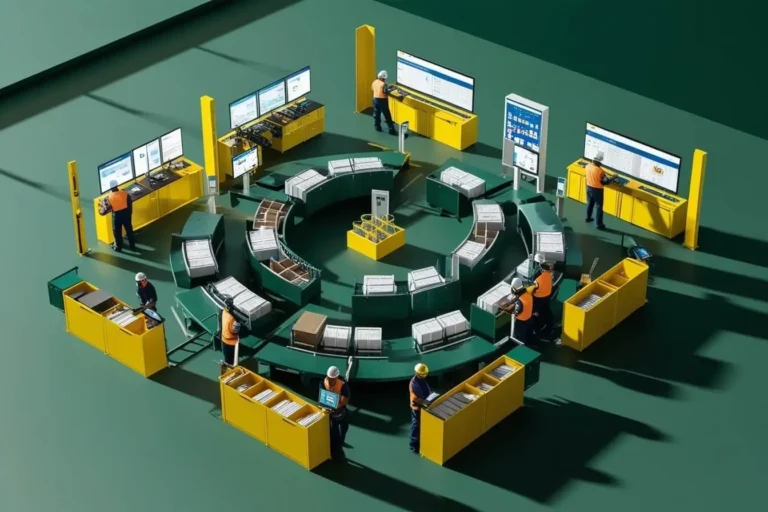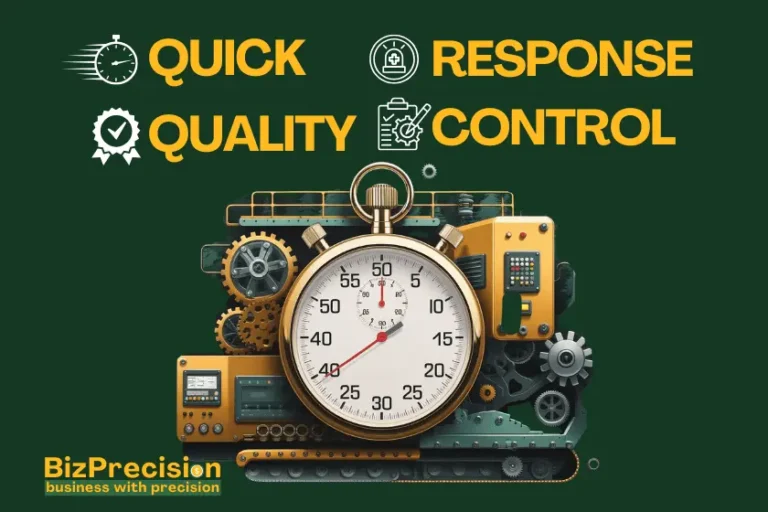The Ultimate Guide to Modern Material Management: Boost Efficiency and Cut Costs
Did you know that businesses can save up to 25% on inventory costs by using smart material management techniques? That’s right! Effective material management is more than just tracking inventory. It helps streamline operations and reduce costs, ultimately improving overall business efficiency.
At its core, it focuses on optimizing resource procurement, storage, and utilization. The goal is to ensure your business has the suitable materials in the right amount, at the right time, and at the correct cost.
Why should you care? Good material management can help companies work better, waste less, and make more money. Studies show that firms with top-notch material management are 20% more profitable than their peers.
In this guide, we’ll break down the ins and outs of modern material management. We’ll look at cool new tech, intelligent strategies, and real-world examples. Whether running a small shop or a big factory, you’ll find actionable tips to help your business thrive. So, let’s delve into and explore this exciting and vital aspect of modern-day business.
What is Modern Material Management?
Definition and Core Concepts
Modern material management focuses on optimizing the supply chain. This ensures seamless operations and helps reduce costs. It’s like being a super-organized shopper for your business. You should recognize what you need, how much, when to get it, and where to find the best deals.
Let’s break down the key components:
- Suitable materials: Identifying and sourcing the exact items your business needs for production or operations.
- Correct quantity: Maintaining optimal inventory levels to avoid stock-outs or excess stock.
- Correct time: Coordinating deliveries to align with production schedules and demand forecasts.
- Right price: Negotiating competitive prices without compromising on quality or reliability.
Modern material management leverages smart technology and innovative strategies to achieve these goals. It’s like having a crystal ball that predicts your business needs before you even realize them!
Evolution from Traditional to Modern Approaches
Old School vs. New School
Back in the day, material management was a bit like guessing. People would order stuff based on what they thought they might need. Sometimes they’d end up with too much, and other times not enough. It was like trying to pack for a trip without knowing where you’re going or how long you’ll be away (trust me, I’ve made that mistake before!).
Today, advanced software and predictive analytics are revolutionizing how we manage materials.
These tools provide:
- Accurate demand forecasting
- Real-time inventory tracking
- Supplier performance analytics
- Automated reordering systems
- Waste reduction algorithms
Tech Takes Over
Modern material management relies heavily on technology. Here are some game-changing innovations:
- Enterprise Resource Planning (ERP) systems: These are like the brains of your business, keeping track of everything from inventory to finance.
- Internet of Things (IoT) devices: Smart gadgets that can count inventory for you and provide real-time data.
- Artificial Intelligence (AI): Like having a super-smart assistant. It can spot patterns. It can make predictions about material needs.
- Blockchain technology: A digital ledger keeps everything transparent and traceable. It ensures authenticity and reduces fraud in the supply chain.
Key Components of Material Management Systems
An effective material management system comprises several crucial elements:
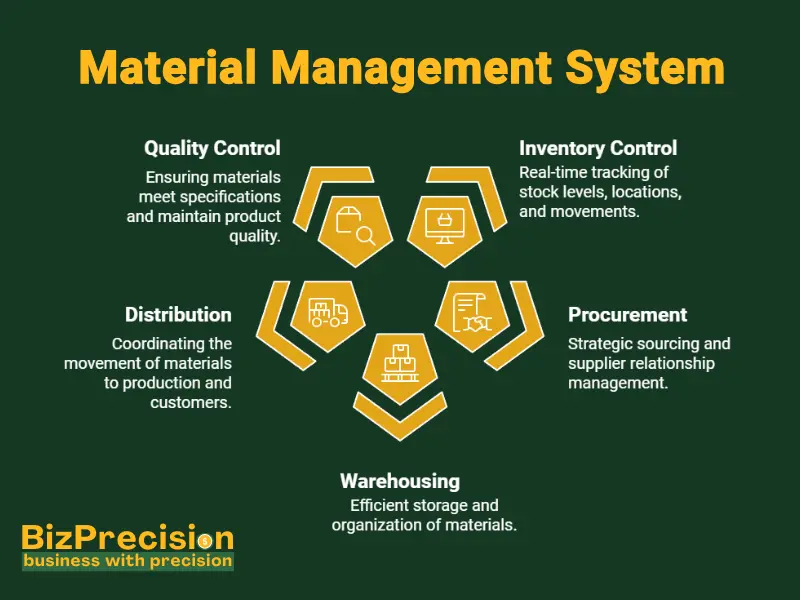
- Inventory Control: This involves real-time tracking of stock levels, locations, and movements. It’s about knowing what you have, where it is, and how fast it’s moving.
- Procurement: The strategic process of sourcing materials, negotiating contracts, and managing supplier relationships. It’s all about getting the best materials at the best prices.
- Warehousing: Efficient storage and organization of materials to maximize space utilization and accessibility. Think of it as creating a logical, easy-to-navigate home for your inventory.
- Distribution: Coordinating the movement of materials from suppliers to production facilities. It also involves getting things to end customers. It’s about placing things where they need to be. And ensuring they arrive when needed.
- Quality Control: Implement rigorous standards and inspection processes. Ensure all materials meet specifications. This helps maintain product quality. It also supports customer satisfaction.
Each of these components works together to create a seamless material management ecosystem. It’s like a well-choreographed dance. Each element plays its part and keeps your business running smoothly.
The Critical Role of Material Management in Business Success
Impact on Operational Efficiency
Good material management is like having a superpower for your business. It makes everything run smoother and faster. Here’s how:
Minimized Downtime
By improving material management, production lines run smoothly. There are no delays caused by shortages. It’s like an assembly line where every part arrives right on time.
Enhanced Resource Utilization
A well-organized system ensures that your workforce and equipment are always productively engaged. It prevents downtime caused by waiting for materials or dealing with excess inventory.
Streamlined Processes
Good material management eliminates bottlenecks and redundancies in your operations. It’s like having a GPS for your business processes, always guiding you along the most efficient route.
Cost Reduction and Profit Maximization
Effective material management is a powerful lever for boosting your bottom line. Here’s how it contributes:
Reduced Carrying Costs: Maintaining optimal inventory levels helps reduce storage and management costs. This approach also frees up capital. With the extra capital, you can invest in other strategic areas.
Minimized Obsolescence: Smart inventory management helps prevent materials from becoming obsolete. It also reduces the chance of materials expiring before they are used. This approach also helps cut down on waste. Additionally, it decreases the need for write-offs.
Improved Cash Flow: Enhancing procurement timing can improve your cash flow position. Negotiating better payment terms with suppliers also helps in this regard. Together, these strategies significantly enhance your financial situation.
Enhancing Supply Chain Resilience
A strong material management system is essential in today’s unpredictable business environment. It serves as a shield against disruptions.
Early Warning System: Advanced analytics can spot potential supply chain issues early. This helps prevent these issues from becoming major problems. This might include identifying suppliers at risk of default or predicting material shortages.
Risk Mitigation Strategies: Effective material management involves creating contingency plans. It also includes diversifying your supplier base. These steps help ensure business continuity in the face of disruptions.
Agility and Adaptability: By using real-time data, you can quickly refine your material management strategies. Flexible systems enhance this process by allowing swift adjustments. This makes it easier to stay ahead of changes. Such responsiveness helps you adapt to market changes. It also enables you to seize new opportunities.
7 Essential Strategies for Effective Material Management
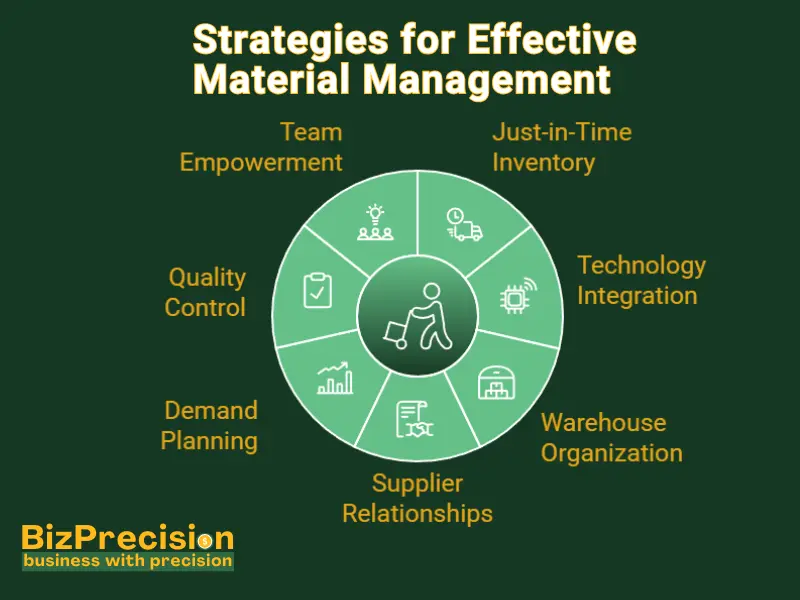
1. Enforcing Just-in-Time (JIT) Inventory
Just-in-time inventory is a game-changing approach that aligns material delivery with production needs. Here’s how to make it work:
What is JIT?
JIT is a strategy where materials are ordered and received only when they’re needed for production. It’s like choreographing a complex dance where every move is precisely timed.
Benefits of JIT
- Reduced storage costs: Minimize the need for large warehouse spaces.
- Improved cash flow: Less money tied up in inventory.
- Enhanced quality control: Easier to track and manage smaller batches of materials.
How to Enforce JIT
- Conduct a thorough analysis of your production processes and material needs.
- Develop strong, reliable relationships with suppliers who can deliver quickly and consistently.
- Invest in tools for robust forecasting to accurately predict material requirements.
- Start with a pilot program and gradually expand JIT across your operations.
2. Leveraging Technology: ERP and MRP Systems
Enterprise Resource Planning (ERP) and Material Requirements Planning (MRP) systems are the backbone of modern material management. They provide a holistic view of your business operations and automate many crucial processes.
What are ERP and MRP?
- ERP: A comprehensive system that integrates all aspects of your business, from finance to human resources to supply chain management.
- MRP: A specialized component focusing on material planning, procurement, and inventory management.
How They Revolutionize Material Management
- Enhanced visibility: Real-time insights into inventory levels, orders, and production schedules.
- Automated planning: AI-driven forecasting and reordering based on historical data and market trends.
- Improved decision-making: Access to comprehensive data and analytics for strategic planning.
Choosing the Right System
- Assess your specific business needs and growth plans.
- Look for user-friendly interfaces and robust mobile capabilities.
- Ensure scalability to accommodate future expansion.
- Invest in comprehensive training to maximize system utilization.
3. Improving Warehouse Layout and Organization
A well-organized warehouse is like a well-organized closet – you can find what you need quickly and easily. Here’s how to make your warehouse work better:
Smart Layout
- Put popular items near the front for easy access.
- Use vertical space with good shelving.
- Create clear paths for people and machines to move around.
Labeling and Tracking
- Use clear labels on everything.
- Apply barcode or RFID systems for quick scanning.
- Maintain a digital map of where everything is located.
Regular Clean-Up
- Conduct regular inventory checks.
- Get rid of old or unused items.
- Keep everything clean and tidy.
4. Developing Strong Supplier Relationships
Good suppliers are like good friends – they’re there when you need them. Here’s how to build strong relationships:
Choose Wisely
- Look for reliable suppliers with good track records.
- Find suppliers who match your values (like eco-friendliness).
Communicate Clearly
- Tell suppliers what you exactly need and when.
- Provide constructive feedback – both positive and negative.
Build Trust
- Pay on time.
- Be loyal to good suppliers.
- Work together to solve problems.
5. Forecasting and Demand Planning Techniques
Forecasting is like being a weather predictor for your business. You’re trying to guess what you’ll need in the future. Here’s how to do it:
Use Data
- Analyze past sales trends.
- Consider seasonal fluctuations.
- Monitor market trends and industry developments.
Use Different Methods
- Apply statistical forecasting (using mathematical models to predict).
- Use qualitative methods (consulting experts for their opinions).
- Combine different methods for more accurate results.
Stay Flexible
- Regularly compare your forecasts against actual outcomes.
- Be prepared to adjust your plans if market conditions change.
6. Quality Control and Continuous Improvement
Quality control is like being a detective for your materials. You’re always on the lookout for problems and ways to make things better.
Set Standards
- Define clear quality criteria for each material.
- Create comprehensive guidelines for quality checks.
Regular Checks
- Identify patterns in quality issues.
- Collaborate with suppliers to address and resolve problems.
- Stay updated with new quality control methods and technologies.
Always Improve
- Look for patterns in quality issues.
- Work with suppliers to fix problems.
- Keep learning about new quality control methods.
7. Training and Empowering Your Team
Your team is your most important asset. Training them well is like giving them superpowers. Here’s how to do it:
Regular Training
- Provide ongoing skill development opportunities.
- Keep everyone updated on new systems and methodologies.
Encourage Ideas
- Solicit team suggestions for process improvements.
- Execute a reward system for innovative ideas.
Give Responsibility
- Delegate leadership roles for different areas of material management.
- Empower team members to make decisions within their domains.
Overcoming Common Challenges in Material Management
Dealing with Supply Chain Disruptions
Supply chain disruptions are like unexpected roadblocks. They can throw everything off course. Here’s how to handle them:
Be Prepared
- Establish relationships with backup suppliers.
- Maintain a safe stock of critical items.
- Develop contingency plans for various scenarios.
Stay Informed
- Monitor global events that might impact your supply chain.
- Enforce real-time tracking systems for material shipments.
Be Flexible
- Develop the ability to quickly adjust plans.
- Identify alternative materials or production methods when needed.
Managing Obsolete Inventory
Obsolete inventory is like old food in your fridge – it takes up space and isn’t useful anymore. Here’s how to deal with it:
Prevent It
- Enforce a strategy for purchasing smaller quantities more frequently.
- Use advanced forecasting techniques to predict future needs accurately.
- Stay informed about market trends to anticipate potential obsolescence.
Deal With It
- Offer discounts on older inventory to encourage sales.
- Explore return options with suppliers.
- Consider donating usable items to charitable organizations.
- As a last resort, properly dispose of obsolete items following environmental guidelines.
Balancing Stock Levels and Cash Flow
Finding the right balance between having enough stock and not tying up too much money is tricky. It’s like walking a tightrope. Here’s how to do it:
Know Your Numbers
- Calculate and understand your inventory holding costs.
- Analyze the turnover rate of different items.
Use Smart Strategies
- Apply ABC analysis to prioritize inventory management efforts.
- Consider consignment inventory arrangements for certain items.
- Apply Just-in-Time principles for fast-moving inventory.
Watch Your Cash
- Avoid over-investing in inventory at the expense of cash flow.
- Negotiate favorable payment terms with suppliers to improve cash flow.
Addressing Communication Gaps
Poor communication is like playing a game of telephone – messages get mixed up and things go wrong. Here’s how to fix it:
Use Good Tools
- Enforce a centralized information system accessible to all relevant parties.
- Establish clear, standardized protocols for data sharing and reporting.
Encourage Talking
- Schedule regular meetings to discuss issues and plan strategies.
- Foster a culture of open communication where team members feel comfortable sharing concerns.
Break Down Silos
- Promote cross-departmental collaboration and information sharing.
- Ensure all team members understand how their work impacts other departments.
Measuring Success: KPIs for Material Management
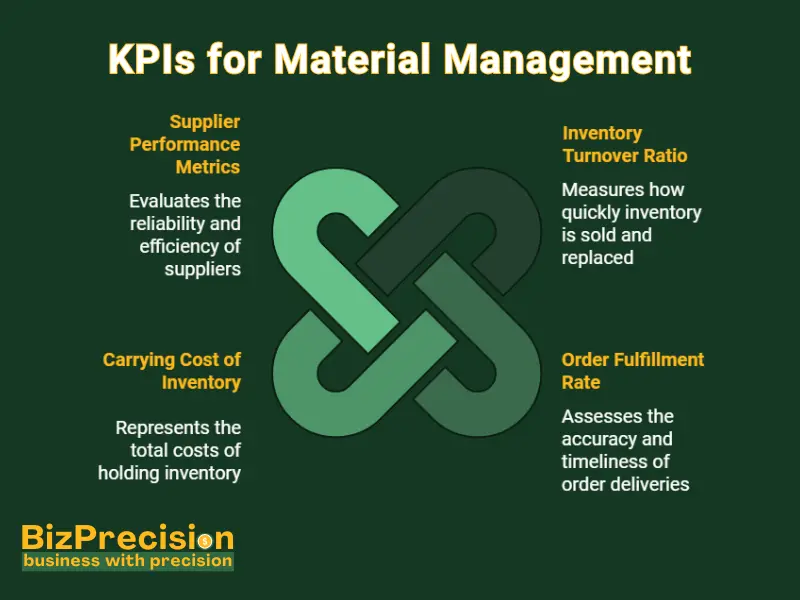
Inventory Turnover Ratio
The inventory turnover ratio is like a speedometer for your inventory. It shows how fast you’re using and replacing your materials.
What It Is
It’s the number of times you sell and replace your inventory over a period, usually a year.
How to Calculate It
Inventory Turnover Ratio = Cost of Goods Sold / Average Inventory
Why It Matters?
- High ratio: You’re selling stuff quickly. Good!
- Low ratio: Your inventory is creeping. Not so good.
How to Improve It
- Execute more accurate forecasting to enhance purchasing.
- Identify and liquidate slow-moving items.
- Enhance marketing efforts to boost sales.
Order Fulfillment Rate
This is like a report card for how well you’re meeting customer orders. It shows the percentage of orders you fill correctly and on time.
What It Is
It’s the number of perfect orders (right items, right quantity, on time) divided by the total number of orders.
How to Calculate It
Order Fulfillment Rate = (Perfect Orders / Total Orders) x 100
Why It Matters?
- High rate: Customers are getting what they want when they want it. They’ll be happy!
- Low rate: You might be losing customers because of poor service.
How to Improve It
- Enhance inventory accuracy through regular audits.
- Streamline picking and packing processes for efficiency.
- Improve shipping methods and partnerships.
Carrying Cost of Inventory
This is like the rent you pay for your inventory. It’s all the costs associated with holding inventory.
What It Is
It includes things like storage costs, insurance, taxes, and the opportunity cost of the money tied up in inventory.
How to Calculate It
Carrying Cost = (Storage Costs + Employee Salaries + Opportunity Costs + Depreciation) / Total Value of Inventory
Why It Matters
- High cost: You’re spending too much on holding inventory.
- Low cost: You’re managing your inventory efficiently.
How to Improve It
- Reduce excess inventory through better forecasting.
- Improve warehouse layout for space efficiency.
- Negotiate better terms with suppliers for just-in-time delivery.
Supplier Performance Metrics
These are like report cards for your suppliers. They help you see which suppliers are doing well and which need improvement.
What to Measure
- On-time delivery rate
- Quality of supplied materials
- Price competitiveness
- Responsiveness to issues
How to Use These Metrics
- Rank suppliers based on their overall performance.
- Work collaboratively with low-performing suppliers to improve.
- Reward high-performing suppliers with increased business.
Why It Matters
Good supplier performance leads to:
- Fewer disruptions in your supply chain
- Higher quality products
- Lower overall costs
How to Improve
- Establish clear expectations and performance targets with suppliers.
- Provide regular, constructive feedback.
- Build strong, mutually beneficial relationships with key suppliers.
Future Trends Shaping Modern Material Management
Artificial Intelligence and Machine Learning
AI and machine learning are like giving your material management system a super-smart brain. They can identify patterns and make predictions more accurately than humans can.
What They Do
- Predict demand with higher accuracy
- Anticipate potential supply chain issues before they occur
- Automatically enhance inventory levels
How to Use Them
- Start small by enforcing AI in one area, such as demand forecasting
- Use AI-powered analytics tools for data-driven insights
- Train your team to work effectively alongside AI systems
Benefits
- More precise predictions lead to better planning
- Faster, more informed decision-making
- Reduced costs and waste through optimized processes
Internet of Things (IoT) in Inventory Tracking
IoT is like giving your inventory items the ability to communicate. They can provide real-time information about their location and condition.
What It Does
- Tracks items in real-time throughout the supply chain
- Monitors environmental conditions (like temperature for perishables)
- Streamlines inventory counts for improved accuracy
How to Implement It
- Begin with high-value or critical items for initial execution
- Use RFID tags or smart sensors for item tracking
- Integrate IoT devices with your existing inventory management system
Benefits
- Significantly improved accuracy in inventory counts
- Enhanced quality control through real-time monitoring
- Reduced labor costs associated with manual inventory management
Sustainable and Green Material Management Practices
Green material management is like being a responsible global citizen. It’s about reducing waste and using resources wisely.
What It Involves
- Including recycled or sustainable materials in production
- Minimizing packaging waste through innovative design
- Enhancing transportation routes to reduce carbon emissions
How to Implement It
- Conduct a comprehensive audit of your current practices
- Set clear, measurable sustainability goals
- Collaborate with suppliers who share your commitment to sustainability
Benefits
- Reduced environmental impact of your operations
- Long-term cost savings through resource efficiency
- Enhanced brand image and appeal to environmentally conscious consumers
Blockchain for Enhanced Transparency
Blockchain, originally popular for its use in cryptocurrency, is now playing a growing role in managing materials and supply chains. Its role in these industries is rapidly expanding.
It creates an immutable and transparent record of every transaction. This encourages trust among all parties involved. It ensures accurate tracking of materials. This tracking occurs from their source to their final destination.
What It Does
- Creates a decentralized, tamper-proof ledger of material transactions
- Tracks the origin and journey of materials throughout the supply chain
- Increases transparency, facilitating easier verification of ethical sourcing
How to Implement It
- Start with areas requiring high transparency, such as supplier certification and product origin tracking.
- Collaborate with suppliers and logistics providers who are adopting blockchain technology.
- Integrate blockchain solutions with existing supply chain management systems.
Benefits
- Greater trust and transparency with suppliers and customers
- Enhanced security in transaction records
- Easier verification of ethical and sustainable sourcing practices
FAQ’s
Conclusion
As highlighted in this guide, effective material management is crucial. It is essential for success in today’s fast-paced, technology-driven world.
By implementing the strategies we’ve discussed, you can boost operational efficiency. Leveraging the technologies can help you cut costs.
Key Takeaways
Remember, good material management is all about having the right stuff, at the right time, in the right amount. It’s like being a super-organized shopper for your business.
Let’s recap the key takeaways:
- Embrace technology: Enforce ERP and MRP systems. Leverage AI and IoT for smarter decision-making.
- Optimize your processes: Use JIT inventory. Improve warehouse layout and develop strong supplier relationships.
- Focus on continuous improvement: Regularly assess your performance using KPIs. Always look for ways to enhance material management practices.
- Prepare for the future: Stay informed about emerging trends like blockchain. Keep up with sustainable practices. Staying updated helps you stay ahead of the curve.
Remember, effective material management is not a one-time effort. It is an ongoing journey. This journey involves continuous optimization and improvement.
As you enforce these strategies, you’ll likely encounter challenges unique to your business. Don’t be discouraged – view these as opportunities to refine your approach and become even more efficient.
By mastering modern material management, you’re not just organizing inventory. You’re setting your business up for long-term success and sustainability.
So, are you ready to take your material management to the next level? The future of your business may depend on it!


